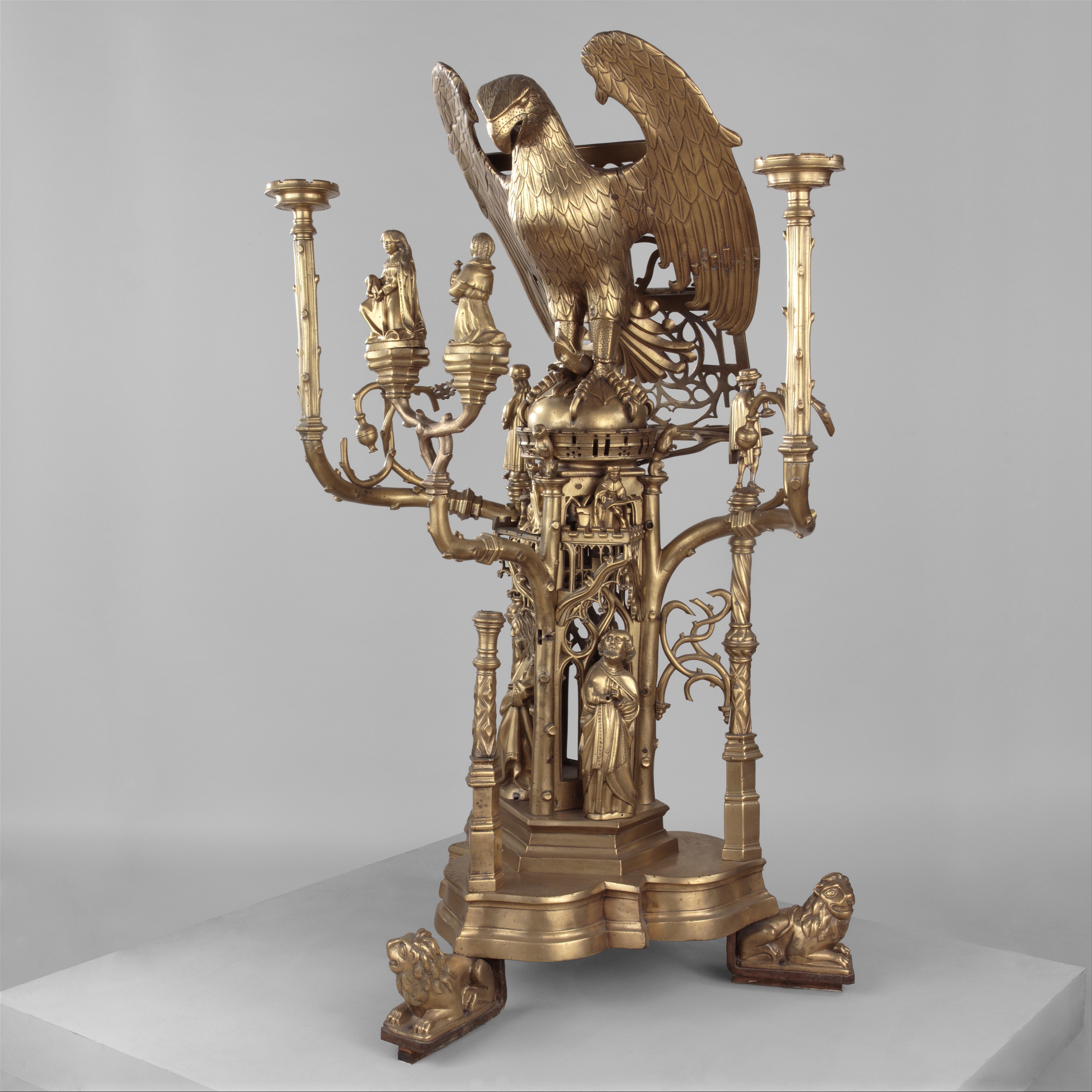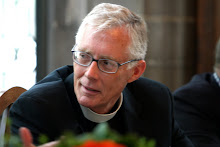
Kathy and I have just returned from a month in New York City, where I serve each December as priest-in-residence at the House of the Redeemer, a retreat house on the upper east side. As a lifelong museum junkie, I use my spare time there to frequent the many wonderful collections both nearby and farther afield.
Last week I decided to revisit the Cloisters, the Metropolitan Museum’s medieval collection at the far northwestern tip of Manhattan. In seminary days I made frequent trips there from Boston, and I have always found it a haven of peace in an otherwise frenetic city.
This year I saw again many of my favorite pieces in the collection and rested in the indoor cloisters festooned with blooming paperwhites. But I also noticed something I had not seen before: a fifteenth century Dutch brass lectern in the shape of an eagle. Now because we clergy tend to be know-it-alls, you may think we know more than we do. But, to speak truthfully, I have always wondered why so many church lecterns are shaped like eagles. I have asked many learned people over the years, and no one has been able to tell me. Then I read the lectern’s accompanying placard:
Churches usually had two lecterns: a large one like this for reading the gospels, and a smaller one for reading the epistles. The eagle is the symbol of Saint John the Evangelist . . . Eagles often adorned lecterns because the first words of the Gospel of Saint John are, “In the beginning was the Word”.
Case closed! Mystery solved! Another question crossed off my life list. My museum encounter with this gospel bird got me thinking not only about life’s unanswered questions but also about our scripture readings for Christmas Day. They all have to do with words, and words are central to the mystery of God becoming one of us in Jesus.
On Christmas Eve we retell the familiar story of Jesus’s birth in Bethlehem. On Christmas Day the church has always turned its attention away from the manger and toward the larger implications of what we call the Incarnation, literally the “enfleshment” of God in the person of Jesus of Nazareth. The great proclamation of God’s enfleshment in us comes in the opening words of John’s Gospel: “In the beginning was the Word, and the Word was with God, and the Word was God.” Today’s earlier readings prepare us for that world- and life-changing announcement.
All of our scriptures today have something to say about words, speech, song, and proclamation. Here is how Isaiah put it:
How beautiful upon the mountains
are the feet of the messenger who announces peace,
who brings good news,
who announces salvation,
who says to Zion, "Your God reigns."—Isaiah 52
Then even the psalmist gets into the act:
Sing to the Lord a new song, *
for he has done marvelous things. —Psalm 98
The author of the Letter to the Hebrews gives a more extended meditation on this:
Long ago God spoke to our ancestors in many and various ways by the prophets, but in these last days he has spoken to us by a Son, whom he appointed heir of all things, through whom he also created the worlds. He is the reflection of God's glory and the exact imprint of God's very being, and he sustains all things by his powerful word. —Hebrews 1
And then, of course, come the familiar yet complicated opening words of John’s Gospel:
In the beginning was the Word, and the Word was with God, and the Word was God. He was in the beginning with God. All things came into being through him, and without him not one thing came into being. What has come into being in him was life, and the life was the light of all people. The light shines in the darkness, and the darkness did not overcome it.—John 1
Since the very beginning of our encounter with God in Jesus, we Christians have wanted to talk about Christ as what philosophers call a “speech act”. Jesus is not only a person. He is God’s announcement of the unbreakable connection between God and us. Yes, Jesus was a healer, a teacher, a critic of religious and political power, but he was also something bigger and deeper. He was God’s proclamation about the universe and our place in it.
Just as I had questions about why church lecterns are shaped like eagles, so each one of us wonders how we and God might be related. Over the millennia of human existence, people have developed two primary images of the divine. We might call the first image the Creator of the Universe, the source of being, the ultimate ground of all that is. We might call the second image my saving God, the one who actually cares about me. The daring of biblical religion—first Judaism, then Christianity—is to proclaim that these two are one and the same. For us Christians, the Creator of the Universe and my saving God meet in Jesus Christ. The one at the center of creation actually knows, and cares about, you and me.
This is why we listen to the opening words of John’s Gospel every Christmas Day: to remind ourselves that Christmas is about something really big and deep. It’s about God becoming one of us in Jesus. It’s about what we ultimately mean in the scheme of things. If, as we believe, God actually took on human experience, then your life has real meaning—more than might appear on the surface. If God lived and suffered as you and I do, then our joys and sorrows are more important than we might otherwise think. The point of Christmas is that, in this impossible transaction between God and us, something has happened which changed both us and God. We are connected, now, in ways that need to be announced, proclaimed, and sung to the world.
One of the other things I did while in New York was to spend some time at Holy Cross Monastery in West Park, the home of the Order of the Holy Cross, of which I am a longtime associate. When you go to a monastery you can enter the routine of its prayer life, and three times a day the brothers ring the bells and pray The Angelus, which allows them, with Mary, to place themselves at God’s disposal. The Angelus consists of three sets of three bells, followed by one set of nine bells each accompanied by prayer.
During the first set of three bells, we pray:
The angel of the Lord brought tidings to Mary,
And she conceived by the Holy Spirit.
During the second set of three bells, along with Mary, we pray:
Here I am, the servant of the Lord;
Let it be with me according to your word.
During the third set of three bells, along with Saint John, we pray
The Word became flesh,
And lived among us.
Then, during the set of nine bells, we pray together:
Pour your grace into our hearts, O Lord,
that we who have known the Incarnation
of your son Jesus Christ,
announced by an angel to the Virgin Mary,
may by his + cross and passion
be brought to the glory of his resurrection:
who lives and reigns with you
in the unity of the Holy Spirit,
one God, now and forever. Amen.
Three days in the monastery reminded me of the monks’ wisdom in praying The Angelus three times a day: it encapsulates what Christmas is all about. The birth of the baby Jesus to Mary and Joseph in the Bethlehem barn announces something big and deep about God, the world, you, and me. “The Word became flesh and lived among us.” God has taken on our life, and we are now taken up into God’s. The birth of Jesus at Christmas inevitably leads us, together, to his resurrection at Easter. We matter. And we now share in the ongoing life and purpose of God in the world.
“Sing to the Lord a new song, for he has done marvelous things.” We all carry around so many unanswered questions, surely about problems larger than lecterns and eagles. Christmas is God’s ultimate answer to all the concerns and the lifting of the burdens we share.
In the beginning was the Word, and the Word was with God, and the Word was God. . . The light shines in the darkness, and the darkness did not overcome it.
Jesus is born and shall be risen, as we too are and will be. You matter. Everyone matters. All will be well. Merry Christmas! Amen.


No comments:
Post a Comment